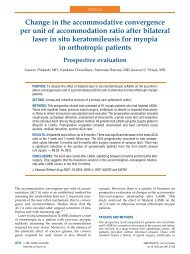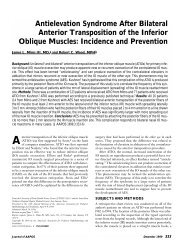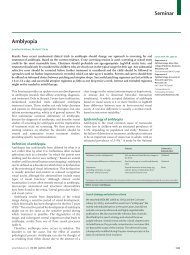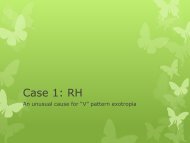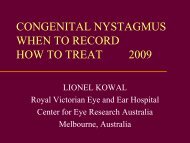What's new AAPOS 2008 - The Private Eye Clinic
What's new AAPOS 2008 - The Private Eye Clinic
What's new AAPOS 2008 - The Private Eye Clinic
Create successful ePaper yourself
Turn your PDF publications into a flip-book with our unique Google optimized e-Paper software.
PREMATURITY<br />
Perinatal care in the threshold of viability: An international comparison of<br />
practical guidelines for the treatment of extremely preterm births.<br />
Pignotti M, Donzelli G.<br />
Pediatrics <strong>2008</strong>; 121(1):e193-e198.<br />
<strong>The</strong> authors conducted a review of published guidelines concerning the different<br />
approaches to the care of extremely preterm births in various countries. <strong>The</strong>y found<br />
that intensive care was justified in age greater than 25 weeks, compassionate care<br />
should be delivered for less than 22 weeks and a variable individual approach to 23 –<br />
24 weeks. As developing countries increased their ability to resuscitate and care for<br />
extremely low birth weight infants the prevalence of retinopathy of prematurity will surely<br />
increase in these countries.<br />
Neurodevelopmental outcome in survivors of periventricular hemorrhagic<br />
infarction.<br />
Bassan H, Limperopoulos C, Visconti K, Mayer D et al.<br />
Pediatrics 2007 Oct; 120(4):785-792.<br />
In the study conducted in Boston 30 premature infants were followed prospectively to<br />
evaluate developmental and cognitive deaths associated with periventricular<br />
hemorrhagic infarction. 26% of the children had significant involvement of the visual<br />
pathways leading to decreased visual acuity or significant visual field deficits. Children<br />
discharged from the hospital with a diagnosis of periventricular hemorrhagic required<br />
close ophthalmic follow-up and early intervention.<br />
Neonatologists’ practices and experiences in arranging retinopathy of<br />
prematurity screening services.<br />
Kemper A, Wallace D.<br />
Pediatrics 2007 Sep; 120(3):527-531.<br />
<strong>The</strong> authors conducted a mail survey of 300 neonatologists to determine their practices<br />
and experiences related to coordinating, screening and treatment for ROP. <strong>The</strong><br />
response rate was 62%. <strong>The</strong> authors found that only 19% of the respondents used the<br />
recommended gestational age criterion of 30 weeks for initiating screening with 6%<br />
using lower, more restrictive criteria, and 70% using a higher, more inclusive criterion.<br />
86% used 1,500 grams as the birth weight for criterion for screening. 46% reported that<br />
retina specialists provided the treatment, although 67% stated that screening was<br />
performed by pediatric ophthalmologists. 30% reported that they could not back<br />
7



